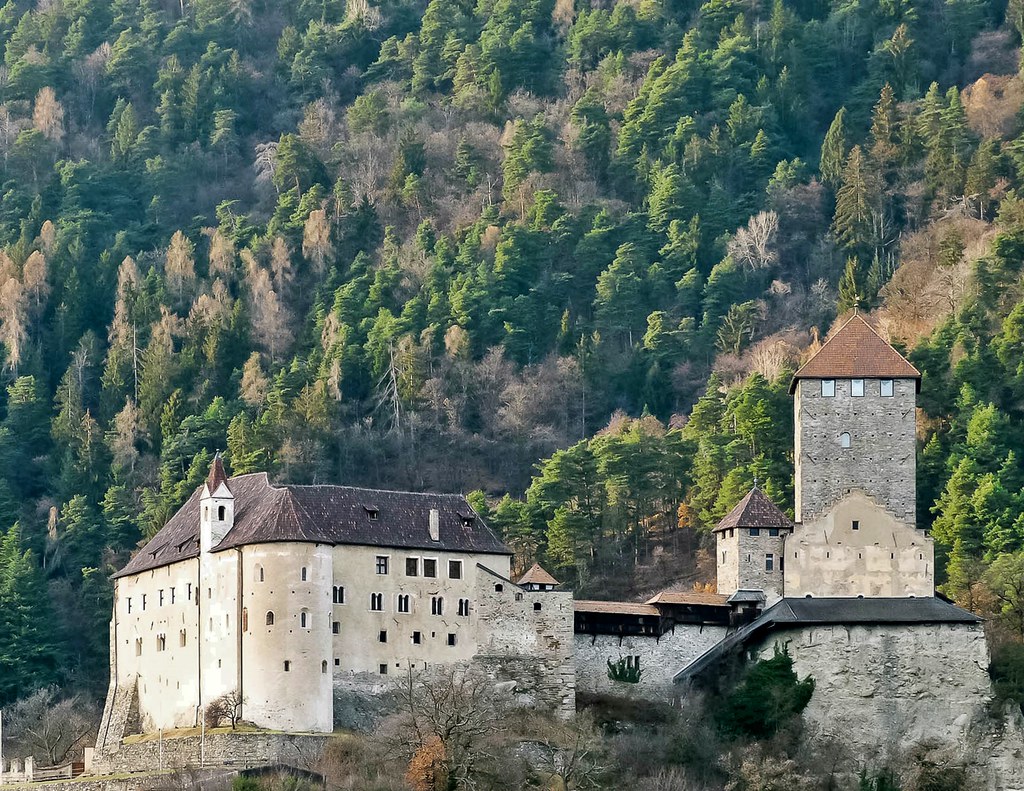Top historic sights in South Tyrol, Italy
South Tyrol combines Mediterranean landscape with Alpine mountains and culture of Italy with German-speaking Austria. The romantic castles surrounded by pictoresque vineyards are waiting for you to visit, as well as Iceman Ötzi!

Trauttmansdorff Castle and Gardens
The origins of Trauttmansdorff Castle go all the way back to the Middle Ages. The structure was first documented in 1300 as Neuberg Castle. The medieval walls are still visible on the southwest side, and the crypt dates from that period.
Read more about Trauttmansdorff Castle and Gardens
Brixen Cathedral
The bishop's residence has been located in Brixen since the sixth century. Between 960 and 990 AD, Brixen supplanted nearby Säben as the episcopal see, and has retained its status since that time. Brixen Cathedral is the highest-ranking church in South Tyrol, and historically one of the most interesting.
Read more about Brixen Cathedral
Bolzano Franciscan Friary
The Franciscan Friary in Bolzano was founded in 1221. According a legend, young Saint Francis accompanied his cloth merchant father, Pietro Bernardone, on a business trip to Bolzano. While there, the young Francis took Mass in the Chapel of Saints Ingenuinus and Erhard, and the bells rang out.
Read more about Bolzano Franciscan Friary
Neustift Abbey
Neustift Abbey is one of the most prestigious monasteries of northern Italy and Alpine region. It was founded in 1142 by the Bishop of Brixen. Buildings have been rebuilt and expanded several times until the 18th century. Neustift Abbey was dissolved by the Bavarian government in 1807.
Read more about Neustift Abbey
Innichen Abbey
The Abbey of Innichen was founded in the 8th century and rebuilt in the 12th–13th centuries.
Read more about Innichen Abbey
Church tower of Lake Resia
The symbol of Val Venosta is quite fascinating and rather like a fable. A solitary church steeple emerges half out of the clear waters of the 6 km long Resia Lake, against the majestic background of the wild Vallelunga Valley.
Read more about Church tower of Lake Resia
Scena Castle
Scena castle, also called Castel Schenna, has first been documented in 1346, but this refers to a forerunner of the building.
Read more about Scena Castle
South Tyrol Museum of Archaeology
South Tyrol Museum of Archaeology was specifically established in 1998 to house 'Ötzi', a well-preserved natural mummy of a man from about 3300 BC. This is the world"s oldest natural human mummy. It has offered an unprecedented view of Chalcolithic (Copper Age) European culture.
Read more about South Tyrol Museum of Archaeology
Sigmundskron Castle
Sigmundskron Castle (Castel Firmiano) is an extensive castle and set of fortifications near Bolzano in South Tyrol. The first historical mention of the castle dates back to AD 945. In 1027 Emperor Conrad II transferred it to the Bishop of Trent. In the 12th century it was given to ministeriales, who from then on were named the Firmian family.
Read more about Sigmundskron Castle
Tyrol Castle
Tyrol Castle was the ancestral seat of the Counts of Tyrol and gave the whole Tyrol region its name. The castle hill has been inhabited since ancient times. Several artefacts and one field of graves from the early Middle Ages have been identified.
Read more about Tyrol Castle
Hocheppan Castle
The Hocheppan Castle with its impressive donjon is located high above Missian, a district of Eppan on the wine route (officially Eppan an der Weinstraße).
Read more about Hocheppan Castle
Marienberg Abbey
Marienberg Abbey was founded in 1149 or 1150 by Ulrich von Tarasp and other nobles. It has maintained a long tradition of education and, at 1,340 m, it is Europe’s highest abbey.
Read more about Marienberg Abbey
Trostburg Castle
The impressive Trostburg Castle in Valle Isarco hosts the South Tyrolean Castles Museum. This one of the most famous and splendid castles of South Tyrol is located on an eastern hillside on a natural rocky promontory.
Read more about Trostburg Castle
Haderburg Castle
Haderburg castle (Castel Salorno in Italian) dates back to Middle Ages and is located on a soaring rock spur above the homonymous village. The castle marks the lingual border of German (or bilingual) and only Italian speaking inhabitants (South Tyrol and Trentino).
Read more about Haderburg Castle